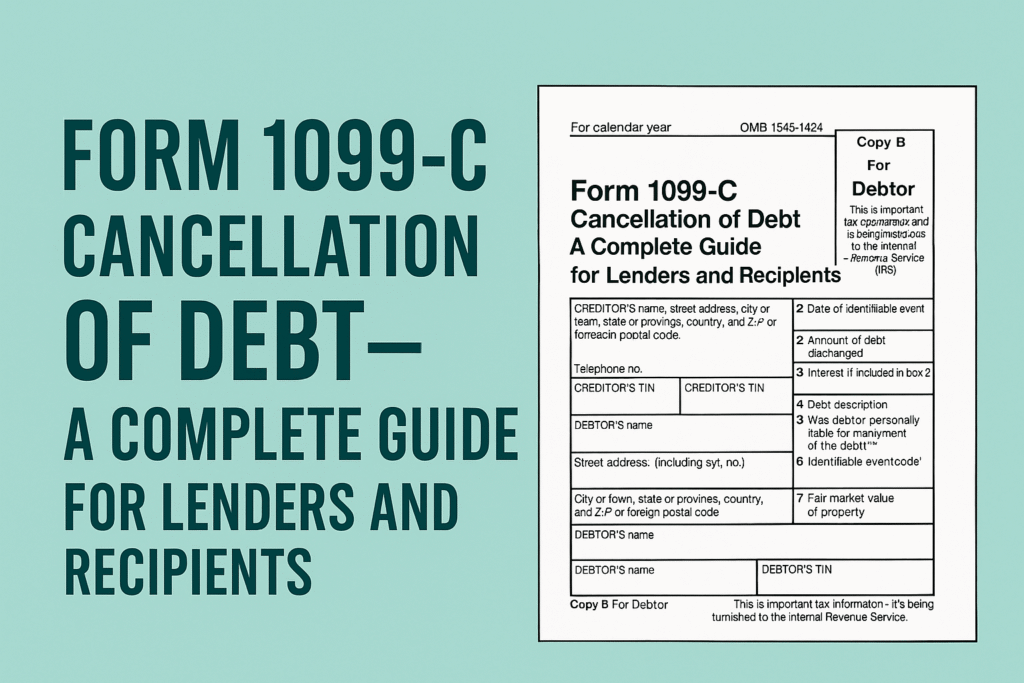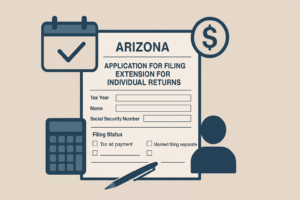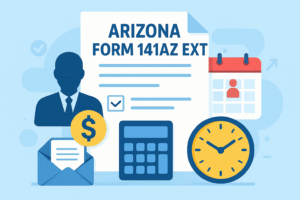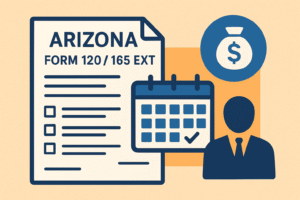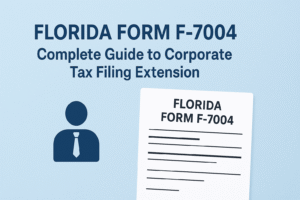When a lender forgives or cancels a debt, the IRS may consider the canceled amount as taxable income for the borrower. To report this to both the IRS and the borrower, the lender uses Form 1099-C, Cancellation of Debt. This article provides a structured explanation of the form, including filing responsibilities, deadlines, box instructions, penalties, exemptions, and recipient responsibilities.
What Is Form 1099-C?
Form 1099-C is used by financial institutions and certain other entities to report the cancellation of a debt of $600 or more. The canceled amount may be considered taxable income for the debtor.
Who Must File Form 1099-C?
Any lender—including banks, credit unions, federal agencies, or other financial entities—that cancels or forgives a debt of $600 or more for an individual, sole proprietor, partnership, or certain trusts must file Form 1099-C. This includes cases where the debt is canceled due to bankruptcy, settlement, expiration of the statute of limitations, or foreclosure.
In cases involving foreclosure or property repossession, the lender may also be required to file Form 1099-A (Acquisition or Abandonment of Secured Property) in addition to or instead of Form 1099-C.
Example:
If a lender repossesses a borrower’s property due to default and later cancels the remaining debt, it must file Form 1099-A to report the acquisition/abandonment and Form 1099-C when the debt is ultimately discharged.
1099-C vs. 1099-A: What’s the Difference?
Both forms are used in debt-related events, but they report different aspects:
| Feature | Form 1099-C | Form 1099-A |
| Purpose | Reports cancellation of debt | Reports acquisition or abandonment of secured property |
| Taxpayer Liability | May indicate income to report | May not automatically result in income |
| Triggering Event | Debt is discharged or forgiven | Lender acquires or knows of abandonment of property |
| Common Use Case | Credit card debt, settled loans | Foreclosures, repossessions |
| Box for Debt Amount | Box 2: Debt discharged | Box 2: Balance of principal outstanding |
| May Receive Both? | Yes, often in foreclosure cases | Yes, when both acquisition and discharge occur |
When Is the Deadline to File Form 1099-C?
- To Recipient: January 31, 2026
- To IRS via Paper: February 28, 2026
- To IRS Electronically: March 31, 2026
Information Required to Complete Form 1099-C
Before preparing Form 1099-C, gather the following essential information:
- Creditor’s details:
- Name of the lender
- Address
- Employer Identification Number (EIN)
- Debtor’s details:
- Full legal name
- Mailing address
- Taxpayer Identification Number (TIN), usually a Social Security Number (SSN)
- Debt information:
- Original amount of the debt
- Amount of debt canceled (excluding accrued interest unless specifically included)
- Amount of interest included in cancellation (if any)
- Date of the identifiable event (i.e., when the debt was considered canceled)
- Description or type of debt (e.g., credit card, auto loan, mortgage)
- Whether the borrower was personally liable for repayment
- Code that identifies the reason for cancellation (e.g., bankruptcy, settlement, foreclosure)
- Property details (if applicable):
- For secured loans, description of the property involved
Importance of Form W-9 Before Issuing Form 1099-C
To ensure accuracy and IRS compliance, creditors should obtain Form W-9 from the borrower before cancellation or disbursement of credit. W-9 provides the debtor’s correct legal name and TIN, reducing the risk of errors and penalties. If a valid W-9 is not on file and the TIN is incorrect or missing, it may result in backup withholding or penalty exposure for the creditor.
What Are the Copies of Form 1099-C?
- Copy A – Sent to IRS
- Copy B – Sent to Debtor
- Copy C – Retained by Creditor
How to Complete Form 1099-C (Box-by-Box)
Here’s a line-by-line guide to completing Form 1099-C for 2025:
Box 1 – Date of Identifiable Event
Enter the date when the cancellation of debt occurred (e.g., settlement date, foreclosure date, or statute expiration).
Box 2 – Amount of Debt Discharged
Include the total amount of principal and accrued fees (excluding interest unless included) that has been canceled.
Box 3 – Interest if Included in Box 2
Briefly describe the nature of the debt. Examples: “credit card debt,” “auto loan,” or “personal loan.”
Box 4 – Debt Description
Briefly describe the nature of the debt, such as “auto loan” or “credit card debt.”
Box 5 – Was Debtor Personally Liable for Repayment of the Debt?
Check this box if the debtor was personally liable. If it was a non-recourse loan, leave this box unchecked.
Box 6 – Identifiable Event Code
Enter the appropriate letter code for the event that triggered the cancellation. Common codes include:
- A – Bankruptcy
- B – Other judicial debt relief
- C – Statute of limitations expiration
- D – Foreclosure election
- E – Debt relief due to probate
- F – Agreement between creditor and debtor
- G – Decision or policy to discontinue collection
Box 7 – Fair Market Value of Property
Enter the fair market value of the property at the time of the identifiable event if the debt is secured by property. This is particularly important in foreclosure cases or repossession scenarios. Leave blank if the debt was unsecured.
Boxes on the Left Side (Creditor and Debtor Information)
- Creditor’s Name, Address, and TIN
- Debtor’s Name, Address, and TIN
Ensure this information matches IRS records to avoid mismatch issues or penalties.
How to File Form 1099-C
File electronically through the IRS FIRE System (mandatory for 10+ forms), or by mail with Form 1096 if fewer. Always retain a copy for your records.
What Are the Penalties for Not Filing Form 1099-C?
- Up to 30 days late: $60/form
- By August 1: $120/form
- After August 1 or not filed: $310/form
- Intentional disregard: $630+/form
Penalties are assessed per form and may increase for larger volumes or repeat non-compliance.
Extension to File Form 1099-C
You may request extensions for filing with the IRS and furnishing recipient statements, but the process differs for each:
📌 Extension to File with the IRS
To request a 30-day extension to file Form 1099-C with the IRS, submit Form 8809.
This extension is automatically granted if filed properly before the due date.
📌 Extension to Furnish Recipient Copies
To request an extension for sending Copy B to the debtor (originally due January 31, 2026), you must file Form 15397. This extension is not automatic and must be justified under one of the following hardship conditions:
- Catastrophic event (natural disaster, fire, etc.)
- Death or serious illness of responsible personnel
- First-time filer with unforeseen difficulties
- Other extraordinary circumstances
Form 15397 must be submitted by the due date of the recipient copy (i.e., January 31, 2026) and should include a clear explanation of the reason for the request.
Exemption to File Form 1099-C
Filing may not be required if the debt:
- Is under $600
- Was owed by a corporation or government agency
- Was a non-recourse loan
- Was discharged under specific student loan relief criteria
What Should a Recipient Do With Form 1099-C?
Recipients may need to report the canceled amount as income unless an exclusion (such as bankruptcy or insolvency) applies. Report it on Schedule 1 of Form 1040 and consider using Form 982 for exclusions.
Final Thoughts
Form 1099-C is essential for tax compliance when a debt is forgiven. Creditors must ensure proper documentation, timely filing, and accurate reporting—starting with collecting a valid Form W-9. Borrowers receiving a 1099-C should carefully assess whether the canceled debt is taxable and consult a tax advisor if insolvency, bankruptcy, or property repossession is involved. Understanding the role of Form 1099-A in related events like foreclosure ensures complete and accurate tax treatment for all parties.

